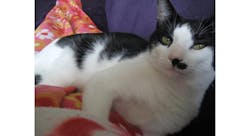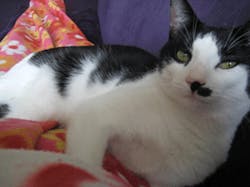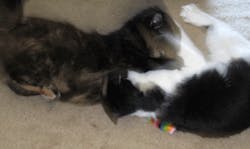Drawing Blood: The Time My Cat Created a Workplace Safety Hazard
Cirrus was in the shelter's "free range" cat area, which was equipped with towering pieces of cat furniture, nooks, crannies and other cats. The moment he got a whiff of the cat carrier and understood that the shelter volunteers were trying to catch him, he panicked and led them on an intense, high-speed chase around the room that culminated in his climb to the top of the cat tree. Once he was cornered and the shelter workers managed to pick him up and aim him toward the cat carrier, he reacted the only way his terrified feline brain knew: He used his claws.
It wasn't pretty. In Cirrus's mad attempt to escape, he shredded the arms of two shelter workers. Blood flew (literally). But those brave shelter workers never lost their cheery atitudes, even as they lost a few inches of their skin.
Cirrus, for his part, was victorious. Thanks to his speed, agility and razor-sharp claws, he was rewarded by spending one more night in the familiar shelter while I took Saucy home alone. I couldn't help but feel guilty that my soon-to-be cat had inflicted such harm on these volunteers. It also made me think about the risks and injuries groomers, animal rescue workers and animal control workers face in the line of duty.
Here are some resources to help you stay safe when working with animals:
► On PetFinder.com, Jacque Lynn Schultz of the ASPCA offers animal handling safety tips for shelter workers, including safe ways to approach or handle sick, aggressive and frightened dogs or cats. "Safe, effective animal handling demands total concentration on the animal you are handling and the knowledge to read the body language that animal is displaying," she writes.
► ASPCA also offers shelter management tips, including suggestions for creating written standard operating procedures; a guide to manging shelter staff and the potential stress and morale issues that may arise; and more.
► PetMD.com offers some safety tips for animal groomers, including this practical advice: "If you have a pet that you feel is dangerous to you or anyone around your facility, you DO NOT have to groom it."
► Finally, NIOSH offers some guidance on working with displaced pets following a natural disaster: "Displaced domestic animals may present a number of occupational safety and health hazards to emergency response and animal rescue workers," the guidance states. "Workers at greatest risk include emergency responders (firefighters, police, and military personnel) and animal rescue workers including animal handlers, animal shelter workers, veterinarians, and veterinary technicians and assistants. However, all workers involved in the evacuation process and early clean-up and remediation efforts are at risk."
NIOSH also cautions, "Only workers who have received proper training in animal restraint, handling, and care should work directly with displaced animals. Employers, response leaders, and volunteer coordinators should ensure that only trained, properly equipped workers are assigned to tasks involving direct animal handling and care."
In the 2 years since, Cirrus and Saucy have settled into their new home, and I'm happy to report that neither cat bites, scratches or acts aggressive. (Toward humans, anyway. This photo, displaying a friendly argument over a catnip-stuffed sock, is another story.)
He might have put up a fight at first, but in the end, I couldn't be happier that Cirrus is my cat — claws and all.
About the Author
Laura Walter Blog
Senior Editor
Laura Walter is senior editor of EHS Today, a Penton Media Inc. publication. She is a subject matter expert in EHS compliance and government issues and covers a variety of topics relating to occupational safety and health. Her writing has earned awards from the American Society of Business Publication Editors (ASBPE), the Trade Association Business Publications International (TABPI) and APEX Awards for Publication Excellence.


